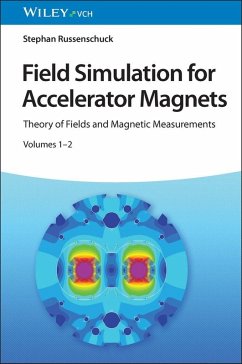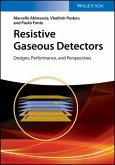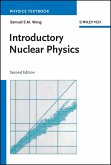Stephan Russenschuck
Field Simulation for Accelerator Magnets 1
Volume 1: Theory of Fields and Magnetic Measurements / Volume 2: Methods for Design and Optimization
Stephan Russenschuck
Field Simulation for Accelerator Magnets 1
Volume 1: Theory of Fields and Magnetic Measurements / Volume 2: Methods for Design and Optimization
- Gebundenes Buch
- Merkliste
- Auf die Merkliste
- Bewerten Bewerten
- Teilen
- Produkt teilen
- Produkterinnerung
- Produkterinnerung
This comprehensive book provides fundamentals of magnetic field design in accelerators as well as detailed coverage of analytical and numerical field computation, mathematical optimization and multiphysics simulations.
Andere Kunden interessierten sich auch für
![Superconducting Radiofrequency Technology for Accelerators Superconducting Radiofrequency Technology for Accelerators]() Hasan PadamseeSuperconducting Radiofrequency Technology for Accelerators122,99 €
Hasan PadamseeSuperconducting Radiofrequency Technology for Accelerators122,99 €![Resistive Gaseous Detectors Resistive Gaseous Detectors]() Vladimir PeskovResistive Gaseous Detectors143,99 €
Vladimir PeskovResistive Gaseous Detectors143,99 €![Introductory Nuclear Physics Introductory Nuclear Physics]() Samuel S. M. WongIntroductory Nuclear Physics158,99 €
Samuel S. M. WongIntroductory Nuclear Physics158,99 €![Introduction to Elementary Particles Introduction to Elementary Particles]() David GriffithsIntroduction to Elementary Particles78,99 €
David GriffithsIntroduction to Elementary Particles78,99 €![Physics of Atomic Nuclei Physics of Atomic Nuclei]() Vladimir ZelevinskyPhysics of Atomic Nuclei120,99 €
Vladimir ZelevinskyPhysics of Atomic Nuclei120,99 €![Fusion 2e An Introduction to Fusion 2e An Introduction to]() Weston M. StaceyFusion 2e An Introduction to148,99 €
Weston M. StaceyFusion 2e An Introduction to148,99 €![Fusion Reactor Design Fusion Reactor Design]() Takashi OkazakiFusion Reactor Design203,99 €
Takashi OkazakiFusion Reactor Design203,99 €-
-
-
This comprehensive book provides fundamentals of magnetic field design in accelerators as well as detailed coverage of analytical and numerical field computation, mathematical optimization and multiphysics simulations.
Produktdetails
- Produktdetails
- Verlag: Wiley-VCH
- Artikelnr. des Verlages: 1141417 000
- 1. Auflage
- Seitenzahl: 1184
- Erscheinungstermin: 16. April 2025
- Englisch
- Abmessung: 244mm x 170mm
- ISBN-13: 9783527414178
- ISBN-10: 3527414177
- Artikelnr.: 71379193
- Herstellerkennzeichnung
- Wiley-VCH GmbH
- Boschstraße 12
- 69469 Weinheim
- wiley.buha@zeitfracht.de
- 06201 6060
- Verlag: Wiley-VCH
- Artikelnr. des Verlages: 1141417 000
- 1. Auflage
- Seitenzahl: 1184
- Erscheinungstermin: 16. April 2025
- Englisch
- Abmessung: 244mm x 170mm
- ISBN-13: 9783527414178
- ISBN-10: 3527414177
- Artikelnr.: 71379193
- Herstellerkennzeichnung
- Wiley-VCH GmbH
- Boschstraße 12
- 69469 Weinheim
- wiley.buha@zeitfracht.de
- 06201 6060
Stephan Russenschuck is a Principle Applied Physicist in the Accelerator Technology (TE) Department of the European Organization for Nuclear Research, CERN, Geneva, Switzerland. He is the leader of the magnetic measurement section in the TE department and the chairman of the technical and doctoral student committee (TSC). He received the Dipl.-Ing and Dr.-Ing. degrees in electrical engineering in 1986 and 1990 both from the Technical University Darmstadt. In 2000 he was recognized as a University Lecturer (Habilitation) for Theory of Electromagnetic Fields at the University of Vienna, Austria. His research interests are mathematical optimization and numerical field computation techniques in support of magnet design, magnetic measurements, and accelerator operation. Stephan Russenschuck is the author of the numerical field computation program ROXIE and the author of the book "Field computation for accelerator magnets" published by Wiley-VCH.
VOLUME 1: FOUNDATIONS OF FIELD COMPUTATION AND MAGNETIC MEASUREMENTS
1 Algebraic Structures and Vector Fields
1.1 Groups, Rings, and Fields
1.2 Mappings
1.3 Vector Spaces
1.4 Affine Space
1.5 Inner Product Space
1.6 Orientation
1.7 Topological Spaces
1.8 Exterior Products
1.9 Identities of Vector Algebra
1.10 Vector Fields
1.11 Phase Portraits
1.12 Matrix Algebra
1.13 The Physical Dimension System
2 Classical Vector Analysis
2.1 Space Curves
2.2 The Directional Derivative
2.3 Gradient, Divergence, and Curl
2.4 Identities of Vector Analysis
2.5 Surfaces in E3
2.6 The Differential
2.7 Differential Operators on Scalar and Vector Fields in r and r'
2.8 Path Integrals
2.9 Coordinate-Free Definitions of the Differential Operators
2.10 A Descriptive Representation of the Curl
2.11 Integral Theorems
2.12 Curvilinear Coordinates
2.13 Integration on Space Elements
2.14 Orthogonal Coordinate Systems
2.15 Transformation of Vector Components
2.16 The Lemmata of Poincaré
2.17 De Rham Cohomology
2.18 Fourier Series and the Discrete Fourier Transform
3 Maxwell's Equations and Boundary-Value Problems in Magnetostatics
3.1 Maxwell's Equations
3.2 Kirchhoff's Laws
3.3 Constitutive Equations
3.4 Energy in Electromagnetic Fields
3.5 Boundary and Interface Conditions
3.6 Magnetic Materials
3.7 Classification Diagrams for Electromagnetism
3.8 Field Quantities Expressed as Differential Forms
3.9 Field Lines
3.10 Boundary-Value Problems 1: Magnetostatics
3.11 Boundary-Value Problems 2: Magnetic Diffusion
4 Fields and Potentials of Line-Currents
4.1 The Dirac Delta
4.2 Green Functions
4.3 Helmholtz Decomposition
4.4 Potentials on Bounded Domains
4.5 The Boundary-Integral Equation for the Magnetic Flux Density
4.6 Properties of Harmonic Fields
4.7 The Biot?Savart Law
4.8 A One-Dimensional Inversion of the Biot-Savart Law
4.9 The Magnetic Dipole Moment
4.10 Magnetic Double Layers
4.11 The Image-Current Method
4.12 Stored Energy in a Magnetostatic Field
4.13 Magnetic Energy in Nonlinear Circuits
4.14 Magnetic Forces and the Maxwell Stress Tensor
4.15 Magnetic Force Calculation by Virtual Displacement
4.16 Fields and Potentials of Magnetization Currents
4.17 The Torque on a Magnetic Dipole Moment
4.18 Magnetic Levitation
5 Harmonic Fields
5.1 Circular Harmonics
5.2 Field Harmonics in Rectangular Domains
5.3 Plane Elliptic Harmonics
5.4 Bipolar Harmonics
5.5 Integrated Multipoles in Accelerator Magnets
5.6 Generalized Gradients
5.7 Zonal Harmonics
5.8 Toroidal Harmonics
6 Complex Analysis Methods for Magnet Design
6.1 The Field of Complex Numbers
6.2 Holomorphic Functions and the Cauchy-Riemann Equations
6.3 Power Series
6.4 Complex Representation of the Field Homogeneity
6.5 Complex Potentials
6.6 Harmonic Polynomials
6.7 Conformal Mapping
6.8 Complex Integration
6.9 The Field and Potential of Line Currents
6.10 Multipoles Generated by a Magnetic Dipole Moment
6.11 The Current-Sheet Theorem
6.12 Electromagnetic Forces on the Dipole Coil
6.13 The Field of a Polygonal Conductor
6.14 Magnetic Flux Density Inside Elliptical Conductors
7 Faraday's Law of Induction
7.1 The Electromotive Force
7.2 Definitions of the EMF
7.3 EMF Formulas
7.4 Faraday Paradoxes
8 Field Diffusion
8.1 Time-Constants and Penetration Depths
8.2 The Laplace Transform
8.3 Conductive Slab in a Time-Transient Applied Field
8.4 Conductive Tube in a Transient Dipole Field
8.5 The LHC Cold Bore
8.6 The LHC Beam Screen
9 Synchrotron Radiation
9.1 The InhomogeneousWave Equations in Free Space
9.2 The Liénard-Wichert Potentials
9.3 The Fields of Moving Charges
9.4 Power Radiated by an Accelerated Ch
1 Algebraic Structures and Vector Fields
1.1 Groups, Rings, and Fields
1.2 Mappings
1.3 Vector Spaces
1.4 Affine Space
1.5 Inner Product Space
1.6 Orientation
1.7 Topological Spaces
1.8 Exterior Products
1.9 Identities of Vector Algebra
1.10 Vector Fields
1.11 Phase Portraits
1.12 Matrix Algebra
1.13 The Physical Dimension System
2 Classical Vector Analysis
2.1 Space Curves
2.2 The Directional Derivative
2.3 Gradient, Divergence, and Curl
2.4 Identities of Vector Analysis
2.5 Surfaces in E3
2.6 The Differential
2.7 Differential Operators on Scalar and Vector Fields in r and r'
2.8 Path Integrals
2.9 Coordinate-Free Definitions of the Differential Operators
2.10 A Descriptive Representation of the Curl
2.11 Integral Theorems
2.12 Curvilinear Coordinates
2.13 Integration on Space Elements
2.14 Orthogonal Coordinate Systems
2.15 Transformation of Vector Components
2.16 The Lemmata of Poincaré
2.17 De Rham Cohomology
2.18 Fourier Series and the Discrete Fourier Transform
3 Maxwell's Equations and Boundary-Value Problems in Magnetostatics
3.1 Maxwell's Equations
3.2 Kirchhoff's Laws
3.3 Constitutive Equations
3.4 Energy in Electromagnetic Fields
3.5 Boundary and Interface Conditions
3.6 Magnetic Materials
3.7 Classification Diagrams for Electromagnetism
3.8 Field Quantities Expressed as Differential Forms
3.9 Field Lines
3.10 Boundary-Value Problems 1: Magnetostatics
3.11 Boundary-Value Problems 2: Magnetic Diffusion
4 Fields and Potentials of Line-Currents
4.1 The Dirac Delta
4.2 Green Functions
4.3 Helmholtz Decomposition
4.4 Potentials on Bounded Domains
4.5 The Boundary-Integral Equation for the Magnetic Flux Density
4.6 Properties of Harmonic Fields
4.7 The Biot?Savart Law
4.8 A One-Dimensional Inversion of the Biot-Savart Law
4.9 The Magnetic Dipole Moment
4.10 Magnetic Double Layers
4.11 The Image-Current Method
4.12 Stored Energy in a Magnetostatic Field
4.13 Magnetic Energy in Nonlinear Circuits
4.14 Magnetic Forces and the Maxwell Stress Tensor
4.15 Magnetic Force Calculation by Virtual Displacement
4.16 Fields and Potentials of Magnetization Currents
4.17 The Torque on a Magnetic Dipole Moment
4.18 Magnetic Levitation
5 Harmonic Fields
5.1 Circular Harmonics
5.2 Field Harmonics in Rectangular Domains
5.3 Plane Elliptic Harmonics
5.4 Bipolar Harmonics
5.5 Integrated Multipoles in Accelerator Magnets
5.6 Generalized Gradients
5.7 Zonal Harmonics
5.8 Toroidal Harmonics
6 Complex Analysis Methods for Magnet Design
6.1 The Field of Complex Numbers
6.2 Holomorphic Functions and the Cauchy-Riemann Equations
6.3 Power Series
6.4 Complex Representation of the Field Homogeneity
6.5 Complex Potentials
6.6 Harmonic Polynomials
6.7 Conformal Mapping
6.8 Complex Integration
6.9 The Field and Potential of Line Currents
6.10 Multipoles Generated by a Magnetic Dipole Moment
6.11 The Current-Sheet Theorem
6.12 Electromagnetic Forces on the Dipole Coil
6.13 The Field of a Polygonal Conductor
6.14 Magnetic Flux Density Inside Elliptical Conductors
7 Faraday's Law of Induction
7.1 The Electromotive Force
7.2 Definitions of the EMF
7.3 EMF Formulas
7.4 Faraday Paradoxes
8 Field Diffusion
8.1 Time-Constants and Penetration Depths
8.2 The Laplace Transform
8.3 Conductive Slab in a Time-Transient Applied Field
8.4 Conductive Tube in a Transient Dipole Field
8.5 The LHC Cold Bore
8.6 The LHC Beam Screen
9 Synchrotron Radiation
9.1 The InhomogeneousWave Equations in Free Space
9.2 The Liénard-Wichert Potentials
9.3 The Fields of Moving Charges
9.4 Power Radiated by an Accelerated Ch
VOLUME 1: FOUNDATIONS OF FIELD COMPUTATION AND MAGNETIC MEASUREMENTS
1 Algebraic Structures and Vector Fields
1.1 Groups, Rings, and Fields
1.2 Mappings
1.3 Vector Spaces
1.4 Affine Space
1.5 Inner Product Space
1.6 Orientation
1.7 Topological Spaces
1.8 Exterior Products
1.9 Identities of Vector Algebra
1.10 Vector Fields
1.11 Phase Portraits
1.12 Matrix Algebra
1.13 The Physical Dimension System
2 Classical Vector Analysis
2.1 Space Curves
2.2 The Directional Derivative
2.3 Gradient, Divergence, and Curl
2.4 Identities of Vector Analysis
2.5 Surfaces in E3
2.6 The Differential
2.7 Differential Operators on Scalar and Vector Fields in r and r'
2.8 Path Integrals
2.9 Coordinate-Free Definitions of the Differential Operators
2.10 A Descriptive Representation of the Curl
2.11 Integral Theorems
2.12 Curvilinear Coordinates
2.13 Integration on Space Elements
2.14 Orthogonal Coordinate Systems
2.15 Transformation of Vector Components
2.16 The Lemmata of Poincaré
2.17 De Rham Cohomology
2.18 Fourier Series and the Discrete Fourier Transform
3 Maxwell's Equations and Boundary-Value Problems in Magnetostatics
3.1 Maxwell's Equations
3.2 Kirchhoff's Laws
3.3 Constitutive Equations
3.4 Energy in Electromagnetic Fields
3.5 Boundary and Interface Conditions
3.6 Magnetic Materials
3.7 Classification Diagrams for Electromagnetism
3.8 Field Quantities Expressed as Differential Forms
3.9 Field Lines
3.10 Boundary-Value Problems 1: Magnetostatics
3.11 Boundary-Value Problems 2: Magnetic Diffusion
4 Fields and Potentials of Line-Currents
4.1 The Dirac Delta
4.2 Green Functions
4.3 Helmholtz Decomposition
4.4 Potentials on Bounded Domains
4.5 The Boundary-Integral Equation for the Magnetic Flux Density
4.6 Properties of Harmonic Fields
4.7 The Biot?Savart Law
4.8 A One-Dimensional Inversion of the Biot-Savart Law
4.9 The Magnetic Dipole Moment
4.10 Magnetic Double Layers
4.11 The Image-Current Method
4.12 Stored Energy in a Magnetostatic Field
4.13 Magnetic Energy in Nonlinear Circuits
4.14 Magnetic Forces and the Maxwell Stress Tensor
4.15 Magnetic Force Calculation by Virtual Displacement
4.16 Fields and Potentials of Magnetization Currents
4.17 The Torque on a Magnetic Dipole Moment
4.18 Magnetic Levitation
5 Harmonic Fields
5.1 Circular Harmonics
5.2 Field Harmonics in Rectangular Domains
5.3 Plane Elliptic Harmonics
5.4 Bipolar Harmonics
5.5 Integrated Multipoles in Accelerator Magnets
5.6 Generalized Gradients
5.7 Zonal Harmonics
5.8 Toroidal Harmonics
6 Complex Analysis Methods for Magnet Design
6.1 The Field of Complex Numbers
6.2 Holomorphic Functions and the Cauchy-Riemann Equations
6.3 Power Series
6.4 Complex Representation of the Field Homogeneity
6.5 Complex Potentials
6.6 Harmonic Polynomials
6.7 Conformal Mapping
6.8 Complex Integration
6.9 The Field and Potential of Line Currents
6.10 Multipoles Generated by a Magnetic Dipole Moment
6.11 The Current-Sheet Theorem
6.12 Electromagnetic Forces on the Dipole Coil
6.13 The Field of a Polygonal Conductor
6.14 Magnetic Flux Density Inside Elliptical Conductors
7 Faraday's Law of Induction
7.1 The Electromotive Force
7.2 Definitions of the EMF
7.3 EMF Formulas
7.4 Faraday Paradoxes
8 Field Diffusion
8.1 Time-Constants and Penetration Depths
8.2 The Laplace Transform
8.3 Conductive Slab in a Time-Transient Applied Field
8.4 Conductive Tube in a Transient Dipole Field
8.5 The LHC Cold Bore
8.6 The LHC Beam Screen
9 Synchrotron Radiation
9.1 The InhomogeneousWave Equations in Free Space
9.2 The Liénard-Wichert Potentials
9.3 The Fields of Moving Charges
9.4 Power Radiated by an Accelerated Ch
1 Algebraic Structures and Vector Fields
1.1 Groups, Rings, and Fields
1.2 Mappings
1.3 Vector Spaces
1.4 Affine Space
1.5 Inner Product Space
1.6 Orientation
1.7 Topological Spaces
1.8 Exterior Products
1.9 Identities of Vector Algebra
1.10 Vector Fields
1.11 Phase Portraits
1.12 Matrix Algebra
1.13 The Physical Dimension System
2 Classical Vector Analysis
2.1 Space Curves
2.2 The Directional Derivative
2.3 Gradient, Divergence, and Curl
2.4 Identities of Vector Analysis
2.5 Surfaces in E3
2.6 The Differential
2.7 Differential Operators on Scalar and Vector Fields in r and r'
2.8 Path Integrals
2.9 Coordinate-Free Definitions of the Differential Operators
2.10 A Descriptive Representation of the Curl
2.11 Integral Theorems
2.12 Curvilinear Coordinates
2.13 Integration on Space Elements
2.14 Orthogonal Coordinate Systems
2.15 Transformation of Vector Components
2.16 The Lemmata of Poincaré
2.17 De Rham Cohomology
2.18 Fourier Series and the Discrete Fourier Transform
3 Maxwell's Equations and Boundary-Value Problems in Magnetostatics
3.1 Maxwell's Equations
3.2 Kirchhoff's Laws
3.3 Constitutive Equations
3.4 Energy in Electromagnetic Fields
3.5 Boundary and Interface Conditions
3.6 Magnetic Materials
3.7 Classification Diagrams for Electromagnetism
3.8 Field Quantities Expressed as Differential Forms
3.9 Field Lines
3.10 Boundary-Value Problems 1: Magnetostatics
3.11 Boundary-Value Problems 2: Magnetic Diffusion
4 Fields and Potentials of Line-Currents
4.1 The Dirac Delta
4.2 Green Functions
4.3 Helmholtz Decomposition
4.4 Potentials on Bounded Domains
4.5 The Boundary-Integral Equation for the Magnetic Flux Density
4.6 Properties of Harmonic Fields
4.7 The Biot?Savart Law
4.8 A One-Dimensional Inversion of the Biot-Savart Law
4.9 The Magnetic Dipole Moment
4.10 Magnetic Double Layers
4.11 The Image-Current Method
4.12 Stored Energy in a Magnetostatic Field
4.13 Magnetic Energy in Nonlinear Circuits
4.14 Magnetic Forces and the Maxwell Stress Tensor
4.15 Magnetic Force Calculation by Virtual Displacement
4.16 Fields and Potentials of Magnetization Currents
4.17 The Torque on a Magnetic Dipole Moment
4.18 Magnetic Levitation
5 Harmonic Fields
5.1 Circular Harmonics
5.2 Field Harmonics in Rectangular Domains
5.3 Plane Elliptic Harmonics
5.4 Bipolar Harmonics
5.5 Integrated Multipoles in Accelerator Magnets
5.6 Generalized Gradients
5.7 Zonal Harmonics
5.8 Toroidal Harmonics
6 Complex Analysis Methods for Magnet Design
6.1 The Field of Complex Numbers
6.2 Holomorphic Functions and the Cauchy-Riemann Equations
6.3 Power Series
6.4 Complex Representation of the Field Homogeneity
6.5 Complex Potentials
6.6 Harmonic Polynomials
6.7 Conformal Mapping
6.8 Complex Integration
6.9 The Field and Potential of Line Currents
6.10 Multipoles Generated by a Magnetic Dipole Moment
6.11 The Current-Sheet Theorem
6.12 Electromagnetic Forces on the Dipole Coil
6.13 The Field of a Polygonal Conductor
6.14 Magnetic Flux Density Inside Elliptical Conductors
7 Faraday's Law of Induction
7.1 The Electromotive Force
7.2 Definitions of the EMF
7.3 EMF Formulas
7.4 Faraday Paradoxes
8 Field Diffusion
8.1 Time-Constants and Penetration Depths
8.2 The Laplace Transform
8.3 Conductive Slab in a Time-Transient Applied Field
8.4 Conductive Tube in a Transient Dipole Field
8.5 The LHC Cold Bore
8.6 The LHC Beam Screen
9 Synchrotron Radiation
9.1 The InhomogeneousWave Equations in Free Space
9.2 The Liénard-Wichert Potentials
9.3 The Fields of Moving Charges
9.4 Power Radiated by an Accelerated Ch








